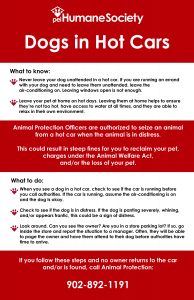Each summer, the PEI Humane Society received hundreds of calls about dogs in hot cars. A dog that is left in a hot car on a hot day can suffer from heatstroke in a matter of minutes. Animal Protection Officers can respond to these calls Island-wide, but often, there is a lot than can be done to help the dog before Animal Protection can arrive on scene. In order to figure our whether or not to call Animal Protection Officers, follow these steps:
- Look around the vehicle. Is the car running? If so, the air conditioning is probably running. If this is the case, monitor the situation and if the dog is in distress, you should call Animal Protection Officers.
- Are the car windows open? How is the temperature today? If the windows are open and the day is not too hot, monitor the situation and if the dog is in distress, you should call Animal Protection Officers.
- If the car is not running and the windows are rolled up, make note of: license plate, vehicle colour, make and model. Call Animal Protection Officers and provide this information immediately.
- Ask managers of nearby businesses to page the owner of the vehicle using the license plate information to return to their vehicle immediately. If the animal is not showing signs of distress, but you are concerned, you can call Animal Protection Officers.
How can you tell if the dog is in distress?
Signs of heatstroke can be hard to identify in dogs. You may notice:
- Exaggerated panting or the sudden stopping of panting altogether
- The dog may salivate excessively
- They may seem anxious or be seemingly staring at nothing
- They may become weak and have muscle tremors
- They will lose coordination, suffer from convulsions, vomiting and may collapse
If you see a “hot dog” this summer, help our Animal Protection Officers by getting as much information as possible about the dog, vehicle and owner and using the above steps BEFORE calling Animal Protection Officers. Together, we can help reduce animal suffering on PEI.
You can reach Animal Protection Officers at 902-892-1190.
After hours, the emergency line for the PEI Humane Society is 902-892-1190.


